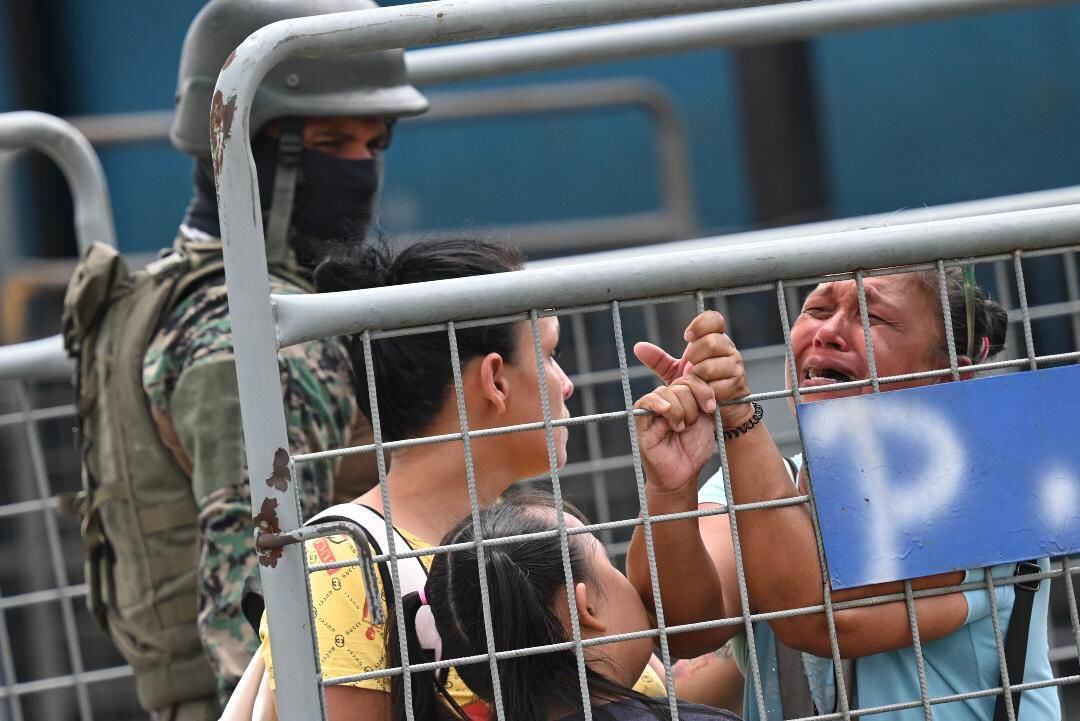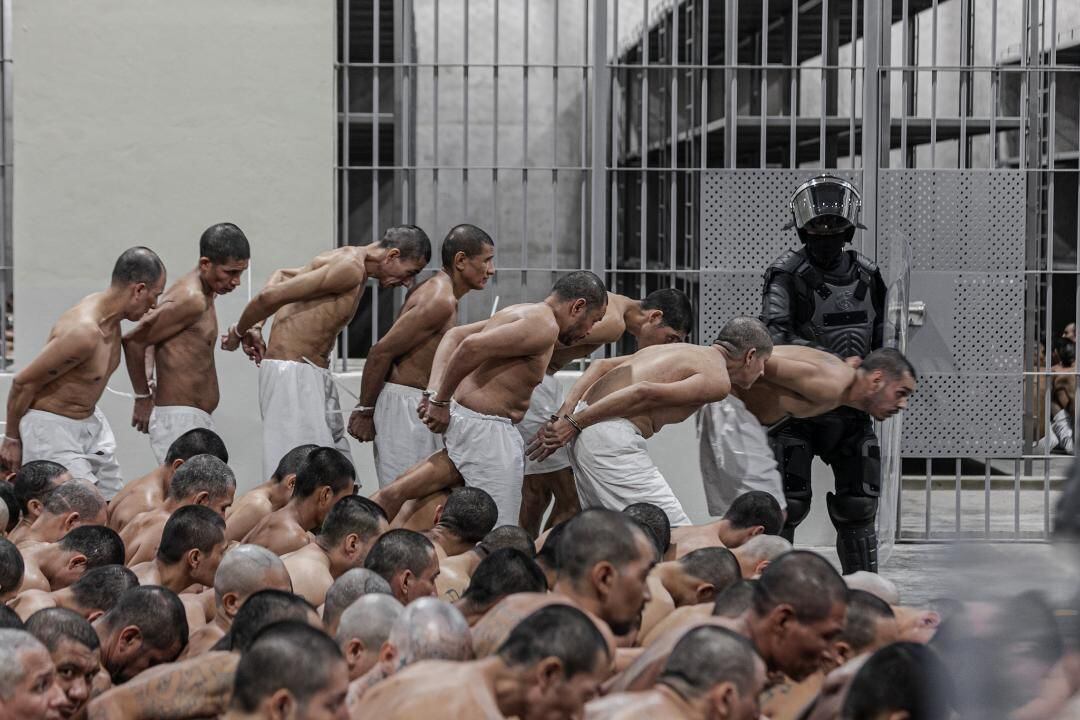In Ecuador, prisons are the epicenter of an unprecedented public security crisis. In Brazil or Venezuela, criminal groups born behind bars are expanding throughout the region. And in Central America, governments take extreme measures against the power exercised by gangs from prisons.
Throughout Latin America, different penitentiaries created by the States to improve the security of those who are outside them have had the opposite effect of what was sought: they became command centers for important criminal organizations.
LOOK: 3 achievements and 3 challenges of Petro a year after his arrival at the presidency of Colombia (and the effect of his son’s scandal)
In general, these gangs that emerged and are directed from prisons have drug trafficking as their main source of income. But specialists believe that some have dabbled in other forms of crime, from extortion to illegal mining.
“Prison is no longer as we had thought,” says Gustavo Fondevila, an expert at the Center for Economic Research and Teaching (Cide) in Mexico.
“These prisons in the region they have become conductors of violence: you build a prison in a place and the level of crime in that area increases”, adds Fondevila in dialogue with BBC Mundo.
“It is a parallel State within the prisons.”
An emblematic case
The prison challenge for Latin American countries has grown as their cells have overflowed with inmates in recent decades, without effective policies to accompany this trend and rehabilitate them.
The prison population in the Americas, excluding the United States, has more than doubled since 2000, according to the World Prison Brief, a global report of prison data published in 2021 by the Institute for Crime and Justice Policy Research (ICPR, for its acronym in English).
This increase in the number of prisoners reached 200% in South America, according to the study, and 77% in Central America.
In Brazil, where the prison population has multiplied by 3.5 since the beginning of this century, a group that emerged in the 1990s inside a prison in São Paulo has come to be considered in recent decades the largest criminal organization in the country and perhaps in South America: the First Command of the Capital (PCC).
Initially conceived as a union for the protection of prisoners with its own statute, the PCC strengthened itself inside the prisons until in 2006 it showed its ability to act in the streets with a series of violent attacks that bathed in blood and paralyzed the largest city in America. Latina.
“Crime strengthens crime” is one of the slogans of the PCC.
The group expanded when the authorities sent its leaders to jails in other Brazilian states where it recruited more members, until it now has close to 30,000 members inside and outside prisons, studies indicate.
Under the leadership of Marcos Herbas Camacho, alias “Marcola” and imprisoned since 1999, the PCC expanded its drug trafficking operations by controlling international routes from Paraguay, Bolivia and other countries region of.

In parallel, he expanded his earnings with other crimes such as bank robberies or sales of stolen phones.
This year, a UN report cited reports of PCC infiltration of illegal gold mining operations in the Amazon and Comando Vermelho, another powerful Brazilian narco group born in a Rio de Janeiro jail.
“Even inside the prison, groups such as the PCC have not completely limited their communication with what is happening on the streets. When we talk about prisoners with greater power and centrality in the organization, surely they have the possibility of maintaining influence, profits (and) the organization of the business”, says Betina Barros, a sociologist and researcher at the Brazilian Forum of Public Security, to BBC World.
In fact, the PCC is an emblematic case of what happens on a different scale in other parts of the region.}
“The effect is paradoxical”
Instead of controlling the interior of the prison of stumpthe authorities of Venezuela they passed the responsibility to the prisoners themselves.
Thus, in addition to a nightclub, a casino and a zoo, it emerged in 2014 in that penitentiary in the center-north of the country. the Tren de Aragua, another Latin American crime transnational.
Apart from drug trafficking, this gang, which has nearly 3,000 members, is credited with a wide range of crimes: from extortion and kidnapping to human trafficking or hit men (and also illegal gold mining such as the PCC, with which it has established ties according to Brazilian authorities).

The most visible figure of the Aragua train, Héctor Rusthenford “Niño” Guerrero, “is protected inside Tocorón and controls the entire operation from there,” said Ronna Rísquez, a Venezuelan journalist and researcher who has authored a book on the gang, in a interview in May.
The lack of control of overcrowded prisons has also been evident in Ecuador, where the government last week declared a state of emergency in a prison system that has been the scene of a series of massacres with more than 450 deaths since 2020.
Behind the Ecuadorian prison violence, experts see a gang war which has also spilled into the streets, where homicides, shootings and attacks have been triggered while the country has become a regional drug distribution center.
“I would say that Ecuador is a narco-state governed from prisons by organized crime,” said Carla Álvarez, a teacher and security researcher, in an interview days ago.

Without going to these extremes, other countries in the region have seen the challenge of drug trafficking behind bars grow.
In Argentina, several people have been arrested accused of transporting kilos of cocaine under the command of imprisoned leaders of “Los Monos”, a narco gang from the city of Rosario, and recently revealed that a former aviation pilot who once supplied the group ran an active network of drug distribution and money laundering from the Ezeiza prison.
In Mexico, where drug lords like Joaquín “El Chapo” Guzmán kept their gigantic illicit businesses in maximum security prisons, it is estimated that up to millions of extortion phone calls are made from prisons every year.
Some Latin American rulers have openly admitted that mafias dominate their prisons.

“We started activities so that prisons stop being schools for crime and break the cycle with organized crime,” said José Manuel Zelaya, Secretary of State for National Defense of Honduras, weeks ago.
In addition to planning the construction of a prison for some 2,000 gang leaders in a Caribbean archipelago, the Honduran government has taken extreme measures to combat crime such as curfews, states of emergency in much of the country and the militarization of overcrowded prisons after several massacres.
This “strong hand” strategy seems to be copied from the one deployed by Salvadoran President Nayib Bukele to reduce the enormous power that gangs had inside and outside his country’s prisons, including the inauguration of a mega-prison for alleged gang members this year.
With the homicide rate plummeting in El Salvador, Bukele enjoys great popularity at the domestic level and is held up by certain politicians in the region as an example to follow.

But some warn that this country is paying too high a price to restore public safety, with the erosion of civil liberties, abuses by security forces and concentration of power in the president.
Others remember that bets just to punish often become a boomerang in Latin America.
“In contexts of high victimization, people want a strong hand. It is perfectly understood: he wants to go out into the street without fear”, says Fondevila.
“But the response of putting everyone in prison for anything in the region has gone very wrong and the effect is paradoxical: we put people in prison to be calm and these people return to society from inside the prison with increasingly serious and complex crimes”.
Source: Elcomercio
I am Jack Morton and I work in 24 News Recorder. I mostly cover world news and I have also authored 24 news recorder. I find this work highly interesting and it allows me to keep up with current events happening around the world.

:quality(75)/cloudfront-us-east-1.images.arcpublishing.com/elcomercio/X5DNLZSBHZFYRKXBR3DJLTRMDM.jpg)

:quality(75)/cloudfront-us-east-1.images.arcpublishing.com/elcomercio/5QRA5RWKN5FGFPV7UOEHREUHZI.jpg)
:quality(75)/cloudfront-us-east-1.images.arcpublishing.com/elcomercio/OA7ASDFTYVDNBF2YEH5MKWXSC4.jpg)
:quality(75)/cloudfront-us-east-1.images.arcpublishing.com/elcomercio/TUAXV33PK5ADXFXDNPKTTVH37Q.jpg)
:quality(75)/cloudfront-us-east-1.images.arcpublishing.com/elcomercio/6T5VR63ZIVHVHIZXGIZCSUVBCM.jpg)
